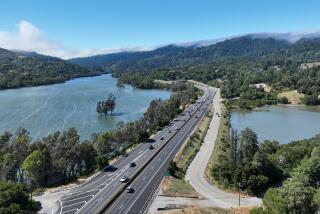Freedom may soon be history for wild horses : Tourist traffic has taken its toll on an Outer Banks herd. A safer ‘range’ is planned.
- Share via
COROLLA, N.C. — A shaggy old stud horse--still in his winter coat--recently wandered out from among the posh oceanfront cottages near the Corolla Lighthouse and onto the side of the two-lane highway. He was trailed by three mares and two of their offspring, one still on wobbly knees.
A black sedan with three youngsters in the back screeched to halt. Behind it a van from Pennsylvania barely missed a rear-ender, as did a pickup on its tail. Within seconds, half a dozen vehicles had stopped on the road to this resort on the northern tip of the Outer Banks, disgorging passengers with cameras.
Oblivious to the commotion, the horses plodded across the highway into another neighborhood, beyond harm’s way.
With the tourist season in full swing come June, as many as 40,000 vacationers a week will arrive in Currituck County. And if the recent past is any guide, automobiles will kill more of Corolla’s wild horses before the summer is over. Fourteen have died on the road since 1989. The herd now numbers 21.
Last year, three were struck down. Another was very nearly killed when it fell from the deck of a beach house where a vacationer had lured it with food.
This will probably be the horses’ last summer among the sunbathers, free to munch on the lawns of cottage owners such as television’s Jane Pauley and Dan Rather and to plod through the flower beds outside of restaurants.
Plans are to move Corrolla’s horses north and fence them onto public lands beyond the end of the highway.
Their exile will be both a victory and a defeat for activists of the Corolla Wild Horse Fund, who post warning signs, shoo aggressive tourists away and generally look after the scattered herd.
They have saved the horses--whose number dwindled to nine at one point--but the state has nixed their suggestion of fencing off a range for them near Corolla.
According to local lore, the Corolla horses are descended from animals brought to the Outer Banks by the Spaniards in the 16th Century and left behind when their effort at colonization failed.
A less romantic, and possibly more accurate, view is that the horses of Corolla and scattered shelter islands from Maryland to Georgia are the progeny of animals that farmers brought from the mainland in the early 20th Century.
Large herds once grazed the lush marsh grass when the Outer Banks were largely inhabited by hunters. In 1926, they were estimated to number 5,000 to 6,000.
The number of wild horses up and down the coastal islands has dwindled in the face of explosive seaside development. But sizable herds have grown on undeveloped public lands, and the National Park Service has undertaken population control efforts where the horses have come to be regarded as a significant threat to the environment.
At the Assateague Island National Seashore--located on a skinny 37-mile-long finger off Maryland and Virginia--a herd that numbered about 20 during the 1960s is expected to reach 180 or more this year.
When the seashore was established 30 years ago, Congress deemed the horses a “desirable feral species” and charged the Park Service with protecting them as a part of the seashore experience. Research later concluded that 120 to 150 animals was an acceptable number.
But Carl Zimmerman, the Park Service official in charge at Assateague, said: “We are seeing unacceptable damage at the present level, and we now think that 150 may be too many.”
Horses foraging for grass are damaging marshes, dunes, delicate plant communities and the habitat of threatened or endangered animals such as the piping plover, loggerhead turtle and Delmarva Peninsula fox.
In an effort to reduce the herd to 150 or less, officials have launched a population control program using dart guns to inject a vaccine that prevents sperm from fertilizing mares’ eggs.
On the southern end of Assateague Island, at the Chincoteague National Wildlife Refuge in Virginia, another herd of 150 horses is fenced in two compounds totaling 4,000 acres.
The Chincoteague Volunteer Fire Department, which has owned the herd since the 1920s, controls the population by holding an annual sale.
Until the mid-1980s, the Corolla horses were unperturbed. Route 12, the two-lane highway beginning at Cape Hatteras and traveling north through the historic communities of Nags Head, Kill Devil Hills and Kitty Hawk, ended at the Dare County line.
But 1984 brought a paved road. The tiny, isolated community that had long existed to serve rich men’s hunting clubs and a lighthouse saw $500,000 cottages springing up. Suddenly, the horses were a tourist attraction, and the accidents started.
One of the fatalities was Star, the herd’s dominant stallion. There is now a marker in his memory near the Corolla Lighthouse. It says that he saw three of his mares and seven of his foals killed before a car got him.
More to Read
Sign up for Essential California
The most important California stories and recommendations in your inbox every morning.
You may occasionally receive promotional content from the Los Angeles Times.













